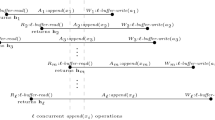Abstract
A barrier are a commonly used mechanism for synchronizing processors executing in parallel. A software implementation of the barrier mechanism using shared variables has two major drawbacks. First, the synchronization overhead is high and second, when a processor reaches the barrier it must idle until all processors reach the barrier. In this paper, the fuzzy barrier, a mechanism that avoids the above drawbacks, is presented. The first problem is avoided by implementing the mechanism in hardware. The second problem is solved by using software techniques to find useful instructions that can be executed by a processor while it awaits synchronization. The hardware implementation eliminates busy waiting at barriers, provides a mask that allows disjoint subsets of processors to synchronize simultaneously, and provides multiple barriers by associating a tag with a barrier. Compiler techniques are presented for constructing barrier regions which consist of instructions that a processor can execute while it is waiting for other processors to reach the barrier. The larger the barrier region, the more likely it is that none of the processors will have to stall. Initial observations show that barrier regions can be large and the use of program transformations can significantly increase their size.
Preview
Unable to display preview. Download preview PDF.
Similar content being viewed by others
References
P. Tang and P.C. Yew, “Processor Self-Scheduling for Multiple-Nested Parallel Loops,” Proc. International Conf. on Parallel Processing, pp. 528–535, August, 1986.
R. Gupta, “Synchronization and Communication Costs of Loop Partitioning on Shared-Memory Multiprocessor Systems,” Tech. Report TR-88-019, Philips Laboratories, Briarcliff Manor, NY, 1988.
H.S. Stone, High-Performance Computer Architecture, Addison-Wesley Publishing Company, 1987.
P.C. Yew, N.F. Tzeng, and D.H. Lawrie, “Distributing Hot-Spot Addressing in Large Scale Multiprocessors,” IEEE Trans. on Computers, vol. C-36, no. 4, April, 1987.
C.D. Polychronopoulos, “Compiler Optimizations for Enhancing Parallelism and Their Impact on Architecture Design,” IEEE Trans. on Computers, vol. 37, no. 8, pp. 991–1004, August, 1988.
J.R. Ellis, Bulldog: A Compiler for VLIW Architectures, MIT Press, 1986.
R. Gupta and M.L. Soffa, “A Reconfigurable LIW Architecture,” Proc. of the International Conf. on Parallel Processing, pp. 893–900, August, 1987.
A.V. Aho, R. Sethi, and J.D. Ullman, Compilers: Principles, Techniques, and Tools, Addison-Wesley, 1986.
J. Hennessy and T. Gross, “Postpass Code Optimization of Pipeline Constraints,” ACM Trans. on Programming Languages and Systems, vol. 3, no. 5, pp. 422–448, 1983.
W.C. Hsu, “Register Allocation and Code Scheduling for Load/Store Architectures,” Dept. of Computer Science; Ph.D. dissertation, University of Wisconsin, Madison, 1987.
D.J Kuck, R.H. Kuhn, D.A. Padua, B. Leasure, and M. Wolfe, “Dependence Graphs and Compiler Optimizations,” 8th Annual ACM Symp. on Principles of Programming Languages, pp. 207–218, 1981.
R. Gupta, “The Fuzzy Barrier: A Mechanism for High Speed Synchronization of Processors,” to appear Third International Conf. on Architectural Support for Programming Languages and Operating Systems, April 1989.
R. Cytron, “Doacross: Beyond Vectorization for Multiprocessors,” Proc. International Conf. on Parallel Processing, pp. 836–844, August, 1986.
“Multimax Technical Summary,” Encore Computer Corporation, Marlboro MA, 1987.
A. Osterhaug, “Guide to Parallel Programming on Sequent Computer Systems,” Sequent Computer Systems, Inc., Beaverton, Oregan, 1987.
Author information
Authors and Affiliations
Editor information
Rights and permissions
Copyright information
© 1989 Springer-Verlag Berlin Heidelberg
About this paper
Cite this paper
Gupta, R., Epstein, M. (1989). Achieving low cost synchronization in a multiprocessor system. In: Odijk, E., Rem, M., Syre, JC. (eds) PARLE '89 Parallel Architectures and Languages Europe. PARLE 1989. Lecture Notes in Computer Science, vol 365. Springer, Berlin, Heidelberg. https://doi.org/10.1007/3540512845_33
Download citation
DOI: https://doi.org/10.1007/3540512845_33
Published:
Publisher Name: Springer, Berlin, Heidelberg
Print ISBN: 978-3-540-51284-4
Online ISBN: 978-3-540-46183-8
eBook Packages: Springer Book Archive




